#Philip II of Macedon
Photo


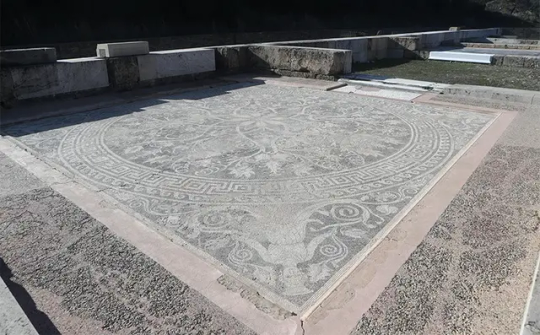


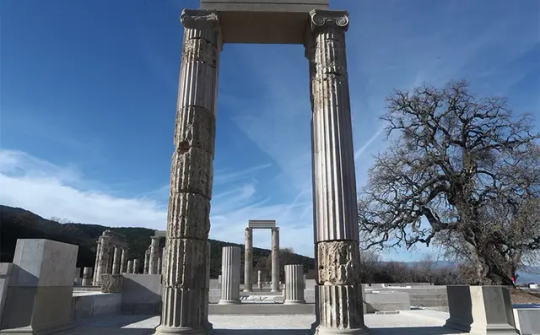
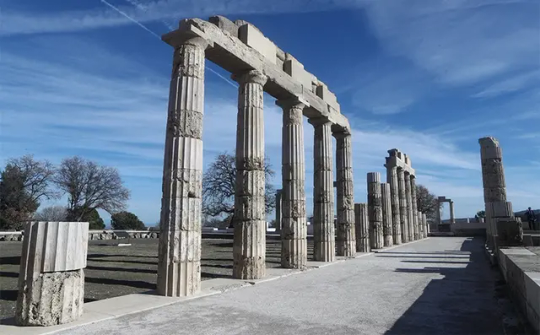
Photos from the Palace of Aegae (~ 350 BC), the royal residence of Philip II of Macedon and his son Alexander the Great, in Aegae, Imathia, Greece. The site can be visited after being closed for many years but it is still under reconstruction works.
Source of the mosaic close-up
Source of the rest of the photos
#greece#europe#alexander the great#philip ii of macedon#ancient greece#macedonia#imathia#aegae#palace of aegae#mainland#greek culture#greek facts#greek history
184 notes
·
View notes
Note
What was Alexander’s relationship with his sisters like?
Short answer: We mostly don’t know.
Longer answer: We have some clues that he may have got on well at least with Kleopatra and Thessalonike. Kynanne is more of a crap-shoot, as she was married to his cousin and rival, Amyntas. But as Philip arranged that marriage, she had little/no say in the matter, so we just don’t know what she thought of her husband-cousin versus her brother. (Not addressing the infant Europe, as she died at just a few weeks.)
First, let me link to an article by Beth Carney, and at the end, I’ll add some links to my own prior entries that address the question too.
Elizabeth Carney, “The Sisters of Alexander the Great: Royal Relics” Historia 37.4 (1988), 385-404.*
Beth’s article discusses Argead marriage policies, and the fate of the women after ATG’s death. I know she’s changed her mind about a few things, but it’s still well worth reading.
Also, a general reminder to folks who may be new to Alexander/Macedonia … Macedonian kings practiced royal polygamy: e.g., they married for politics, not love, and had more than one wife at the same time. Philip married 7 women (the most of any Macedonian king), although there weren’t 7 wives living in the palace at once. There may have been as many as 5 at times, however.
Because of royal polygamy, they did not use the term basilissa (queen) until after Alexander’s death. The chief wife was the mother of the heir; she had the most power. Because of the rivalry inherent in such courts, a woman’s primary allegiance was to her son, not her husband. Her secondary allegiance would be to her father (if living) and/or brothers. This was not unique to Macedonia, but a feature of most courts with polygamous structures.
These are not love matches, although our later sources may present them as love matches. (These authors had their own ideological reasons for such characterizations.) Did love never come after marriage? Perhaps. It would have depended. Also, within the women’s rooms, wives may have allied with each other at points, particularly if several of them. If only two (as seems more characteristic in Macedonia, aside from Philip), they’d have been rivals seeking to produce the heir.
I state all that to explain why Alexander’s sisters may have courted their brother’s affection (and protection), after Philip’s death. Only Kleopatra had a son, and he was 12 at most at Alexander’s death.

In his final year, Philip married off Alexander’s older sister, Kynanne (d. of Audata, ergo half- Illyrian), and Alexander’s younger and only full sister, Kleopatra (d. of Olympias). Kleopatra’s wedding was literally the day before Philip’s assassination. The timing of Kynnane’s marriage is less clear, but Philip married her to Amyntas, his nephew (her cousin), some time after his own marriage to his last wife, Kleopatra Eurydike. Kynnane had a daughter by Amyntas, Hadea (later Hadea Eurydike). We’re not sure if she was born before or after her father’s execution by Alexander, but it does let us nail down her age to c. 12/13 at Alexander’s death.
After he had Amyntas executed, Alexander planned to marry Kynnane to one of his trusted allies, Langaros, king of Agriana, which lay north of Macedonia, between Paionia and Illyria. Agriana was arguably Paionian, but similar to Illyria. Ergo, this may show a bit of thoughtfulness on Alexander’s part, to match his sister to a man who wouldn’t attempt to trammel her. Recall that Illyrian women wielded more power and even fought in battle. Yet Langaros died (perhaps of injury) before Alexander could make good on that.
It would be the last time Alexander planned any nuptials for his sisters. In part because he invaded Persia not long after, but it wouldn’t have stopped him from summoning one of them if he’d really wanted to marry her off.
Kynanne raised her daughter Hadea in traditional Illyrian ways, which Alexander allowed (although he probably couldn’t have stopped her). After his death, she took off to Asia to see Hadea married to her uncle, (Philip III) Arrhidaios. Kynanne was murdered by Perdikkas’s brother Alkestas, because Perdikkas (then regent) didn’t want the marriage. BUT the army (who liked and respected Kynanne) forced Alkestas to allow it anyway. Hadea (now) Eurydike and Philip III Arrhidaios eventually fell under Kassandros’s authority/possession, where she/they opposed Olympias and baby Alexander IV (and Roxane).
It was inevitable that the co-kingship that followed ATG’s death wouldn’t hold, and Hadea, who clearly wore the pants, wasn’t about to step aside for her cousin Alexander IV. Nor did Kassandros want them to, as he could control them. He couldn’t control Olympias. Yet none of that would necessarily reflect how Kynanne and Hadea had felt about their brother/uncle during his lifetime.
So, we must say the jury is out on Kynanne’s relationship with Alexander.
But for Kleopatra and Thessalonike, I do believe we have enough hints that they cared for him and he for them.
Kleopatra’s husband (another Alexander, of Epiros) died in combat in Italy in 332—around the time Alexander was besieging Tyre and Gaza, or four years after their marriage. In that time, Kleopatra produced two children, a girl (Kadmea) and a boy (Neoptolemos). The girl was named to honor her uncle’s victory over Thebes,** which happened at the tail-end of 335. As Alexander of Macedon and Alexander of Epiros both left on separate campaigns in 334, the boy would have to have been fathered not long after Kadmea was born. (It’s possible that Alexander of Epiros didn’t get to Italy until 333.)
After Alexander of Epiros’s death, Kleopatra did not marry again, although after her brother died, she had a couple marriage offers/offered marriage herself. She was THE prize during the early Successor wars…the full sister of Alexander.
Two titbits might suggest she was close to him (even if he didn’t marry her off again). First, the name of her first child is for his victory, not one by her husband. Sure, Alexander of Epiros didn’t have a battle victory at that point to name her for…but he could have insisted on a family name. Instead, he let Kleopatra give the child a name celebrating Alexander of Macedon’s victory. I suspect she fought for that.
Second, an anecdote reports that when Alexander was told his sister was having an affair some years after she’d become a widow, he reportedly replied, “Well, she ought to have a little fun.” This, btw, was viewed as a bad answer…e.g., he didn’t properly discipline her. As Alexander was constantly used for moral lessons (good or bad), we should take it with a grain of salt. But it’s possible his approximate reaction was preserved and became fodder for moralizing about those wild, half-barbarian Macedonians from the north…couldn’t keep their women in check!
As for Thessalonike, data here is also circumstantial. She stayed with Olympias after Alexander’s death and was never married until after Olympias herself was killed by Kassandros—who then forced her to marry him to cement his claim to the Macedonian throne. She had a sad life, at least in her latter years. Her eldest son (Philip) wasn’t healthy and died not long after he became king. Her second son (Antipatros) and her last son (Alexandros) apparently hated each other. After Philip’s death, Thessalonike argued that Antipatros should co-rule with the younger Alexandros. So Antipatros killed his mother! (Matricide, folks, is SUPER-bad.) Then Alexandros killed Antipatros, and was eventually killed in turn by Demetrios Poliorketes.
Well, if Justin can be trusted, and there are problems with Justin. Ergo, it’s possible that internecine spate of murders didn’t go the way Justin reports.
Yet the naming of her youngest boy may tell a story, along with her insistence that he co-rule with his brother.
There’s also the legend of Mermaid Thessalonike, but we can’t take that as any sort of evidence.
Here are some additional posts that also talk about the sisters:
“Writing Kleopatra and Alexander’s Other Sisters” — Although aimed primarily at the novels, it obviously must deal with the girls as historical persons. Pretty short for me.
“What Philip Thought about His Other Children” — A sideways take on this same question. Not long.
“On Amyntas” — About Alexander’s older cousin, his real rival for the throne when Philp was assassinated. Also discusses Kynanne as a matter-of-course. Not long.
“On Kassandros” — Mostly about Antipatros’s son Kassandros, who had Alexander IV murdered, but also discusses Thessalonike, who he forced to marry him. Relatively long.
--------------------------------------------
* The link takes you to academia.edu, where, by clicking on Beth’s name, you can find more of her articles. Keep in mind the woman has something north of 150, many on women, PLUS a bunch of books. Not everything is uploaded due to copyright, but several of her older articles are, such as this one.
** It was something of a “thing,” at least in Macedon, for daughters to be named in honor of their father’s victories. Kynanne not so much, but Kleopatra means “Glory of Her Father,” and both Thessalonike (Victory in Thessaly) and Europe (Victory in Europe) reflected their father’s triumphs.
#asks#alexander the great#alexander the great's sisters#kleopatra of macedon#thessalonike of macedon#kynnane of macedon#hadea eurydike#philip II of macedon#philip of macedon#alexander of epirus#classics#ancient macedonia#ancient greece#alexander's sisters#ancient greek family relations
18 notes
·
View notes
Text
Philip II : For the last time, Alexander, you cannot be a part of this family if you are a satanist!
Alexander : ...
Alexander : I was literally just eating a salad.
#alexander the great#alexander the making of a god#philip ii of macedon#I have a hyper fixation on Alexander the Great#and the docu-series is very good#I'm gay and autistic#what more do you need to love Alexander#incorrect quotes
16 notes
·
View notes
Text
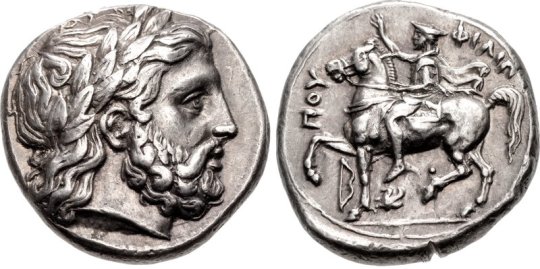
Tetradrachm of Philip II of Macedon. On the obverse, the laureate head of Zeus (from whom the Argead dynasty of Macedon claimed descent via Heracles); on the reverse, Philip, on horseback and wearing the characteristic Macedonian flat hat known as the kausia. Artist unknown; minted at Amphipolis between 355 and 348 BCE. Photo credit: Classical Numismatic Group, Inc. http://www.cngcoins.com
#classics#tagamemnon#Ancient Greece#Macedon#Philip II of Macedon#Classical Greece#ancient history#Greek history#Ancient Greek history#art#art history#ancient art#Greek art#Ancient Greek art#Classical Greek art#Macedonian art#coins#ancient coins#Greek coins#Ancient Greek coins#Macedonian coins#numismatics#ancient numismatics#tetradrachm
69 notes
·
View notes
Text

Lion of Chaeronea (Χαιρώνεια; Boeotia, Greece)
This lion commemorates the defeat of Thebes by Philip II of Macedon in 338 BCE at the Battle of Chaeronea. This monument (a modern reconstruction; parts of the original reside in the British Museum and the Louvre) sits atop the site of a fourth-century mass grave, believed to be the fallen of the Sacred Band of Thebes.
#isaac.jpg#art#archaeology#classical archaeology#greek#macedonia#philip ii of macedon#thebes#sacred band of thebes#chaeronea#lion of chaeronea#χαιρώνεια#hellenistic
37 notes
·
View notes
Text
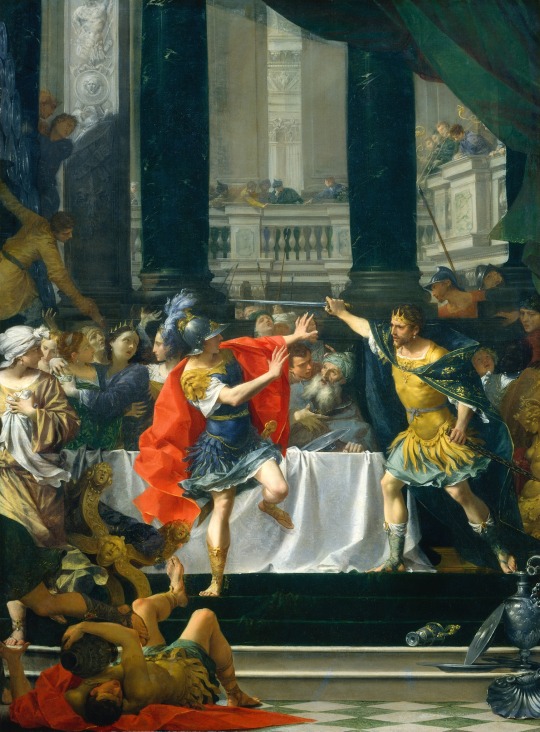
Alexander the Great Threatened by His Father
by Donato Creti
#alexander the great#alexander#father#philip ii of macedon#art#painting#history#europe#european#macedon#macedonia#ancient#greek#greece#architecture#classical#donato creti
28 notes
·
View notes
Text
"Such was the end of Philip, who had made himself the greatest of the kings of Europe in his time, and because of the extent of his kingdom had made himself a throned companion of the twelve gods"
Diodorus Siculus book 16.
7 notes
·
View notes
Text
Aristotle's school - The world's greatest ancient educational institution in Naoussa
Aristotle’s school – The world’s greatest ancient educational institution in Naoussa
The ruins of school is the site where the greatest philosopher of the antiquity taught the greatness of classical Greek thought and the ideals of the Platonic philosophy to the King’s of Macedonia, Phillip II, son, Alexander and the other nobles of the Macedonian court. Aristotle was hired by Alexander’s father, Philip II of Macedon, to teach his son, and was given the Temple of the Nymphs as…

View On WordPress
#Alexander III of Macedon#Alexander the Great#Ancient Mieza#Aristotle#Aristotle School#caves#Delacoulonce#Fotis Petsas#Nympheon#Philip II of Macedon#school
2 notes
·
View notes
Text
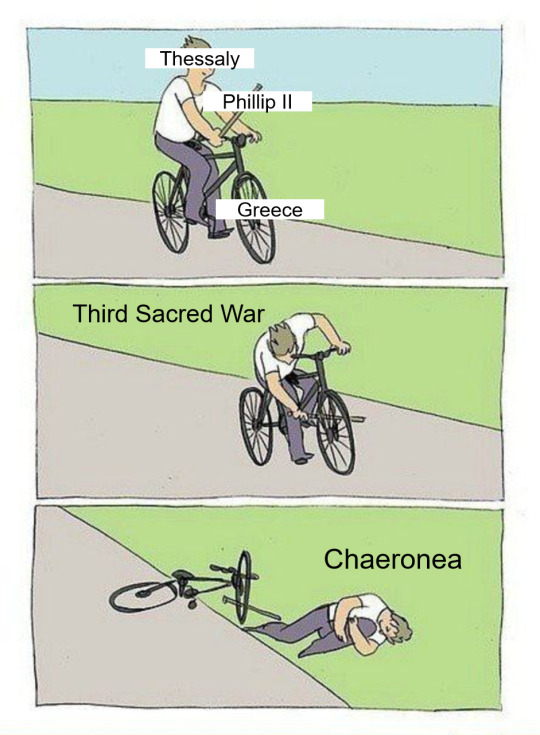
"But for the other Thessalian cities there was an alternative too... The principle of using Macedon as a stick to hit their enemies may have been the same as that applied in the 360s and even early 350s, but the concrete results were certain to be very different given the strength of Philip’s position after a mere six years of rule"
Simon Hornblower, The Greek World 479-323 BC, p. 277.
#tfw ur hitty stick makes the league of corinth#sorry i just finished my essay so i dont have the willpower to fight off the brainworms#tagamemnon#history memes#ancient greece#philip ii of macedon
6 notes
·
View notes
Text
Some Guy: I wouldn't touch that with a 20 foot pole!
Philip II of Macedon: ...what did you just say?
#Philip of Macedon#philip ii#philip ii of Macedon#alexander the great#Macedonian Empire#Macedonian sarrisa
0 notes
Text
Okay, but like, what did Alexander the 'Great' even do? The nepo baby gets an army, kills his cousin, and conquers an empire? Like, good job? But I bet your dad would have done better.
#alexander the great#ancient history#ancient greece#history#Alexander III of Macedon#philip II of Macedon
1 note
·
View note
Text
More than Classical
Ever wonder what happened to Athens after her defeat in the Peloponnesian War?
If you’re curious, please check out my review for World History Encyclopedia on Ian Worthington’s, Athens After Empire.
#ancient greece#ancient athens#alexander the great#philip ii of macedon#macedonia#rome#roman empire#hadrian#ian worthington#classics#education
1 note
·
View note
Text

Philip II of Macedon Pendant Necklace Ancient Silver Greek Macedonian Coin.
#Philip#king#alexander the great#philip ii of macedon#macedonian#greek#ancient#coin#pendant#necklace#jewelry#jewellery#men jewelry#women jewelry#mens gifts#womens#women gifts
0 notes
Video
youtube
Who killed my father?
You rare no blood to that man.
0 notes
Text
I think every world-historical conqueror should break a few bones, the better to identify their skeletons afterward
30 notes
·
View notes
Photo
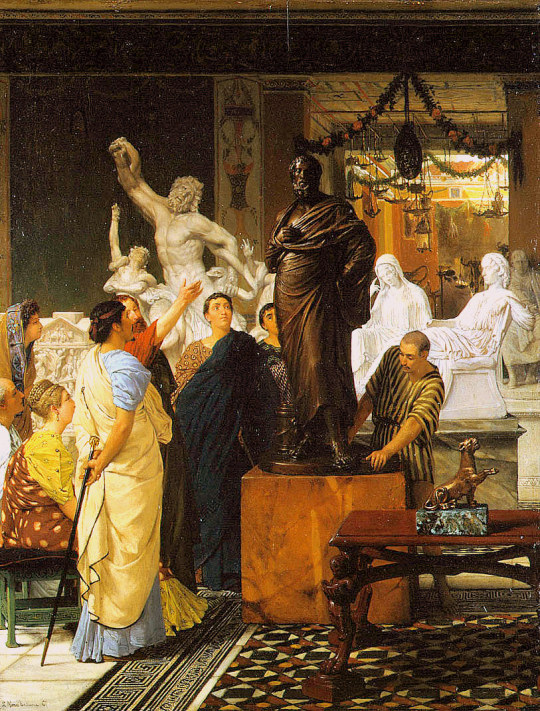

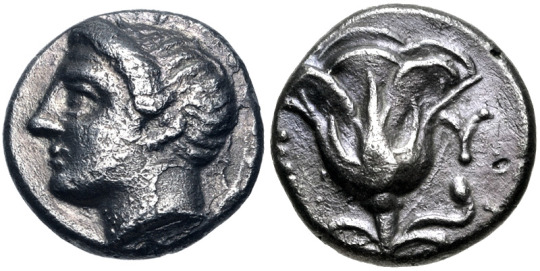
A Sculpture Gallery in Rome at the Time of Agrippa by Lawrence Alma-Tadema + Memnon of Rhodes by Dalton Thomas Rix + Coinage of Memnon of Rhodes, Mysia. Mid 4th century BC
Memnon's career in Persian service had a strange start. In fact, the Persians needed his brother Mentor to defend the Troad (the northwest of modern Turkey), and gave him land in that region. Not much later, Mentor was made Persian supreme commander in the West and married Barsine, the daughter of the satrap of Hellespontine Phrygia, Artabazus, who married a sister of the Rhodians.
Memnon joined his brother and shared in his adventures. For example, when Artabazus rebelled against king Artaxerxes III Ochus in 353 or 352, they assisted him. The revolt was not successful, and Artabazus and Memnon were forced to flee to Pella, the capital of Macedonia. Here, they met king Philip, the young crown prince and the philosopher Aristotle of Stagira.
...
The Persians dug themselves in on the banks of the river Granicus, the modern Biga Çay. If Alexander moved to the south, where he wanted to liberate Greek towns like Ephesus and Miletus, they could attack his rear; if he moved to the east to drive them out, their position was strong enough to withstand the attack of a larger army. However, the Persians were defeated (June 334).
Darius, however, understood that Memnon had been right about his strategy. He ordered the Persian navy to move to the Aegean sea; it had to come from Egypt, Phoenicia, and Cyprus, and it arrived three days too late to prevent the capture of Miletus. However, Memnon, now appointed supreme commander, managed to keep the Persian naval base Halicarnassus (modern Bodrum) for a long time and was able to evacuate the town without unacceptable losses. In fact, Halicarnassus was the last Persian victory: after the siege, Alexander needed reinforcements, and it gave the Persians the opportunity to regroup.
—Memnon of Rhodes at Livius.org
Memnon, one of King Darius’s generals against Alexander, when a mercenary soldier excessively and impudently reviled Alexander, struck him with his spear, adding, I pay you to fight against Alexander, not to reproach him.
—Plutarch, Morals vol. 1
#Memnon of Rhodes#Dalton Thomas Rix#Lawrence Alma-Tadema#King Philip II of Macedon#Darius III#Aristotle#Laocoön#Alexander the Great#Plato
2 notes
·
View notes